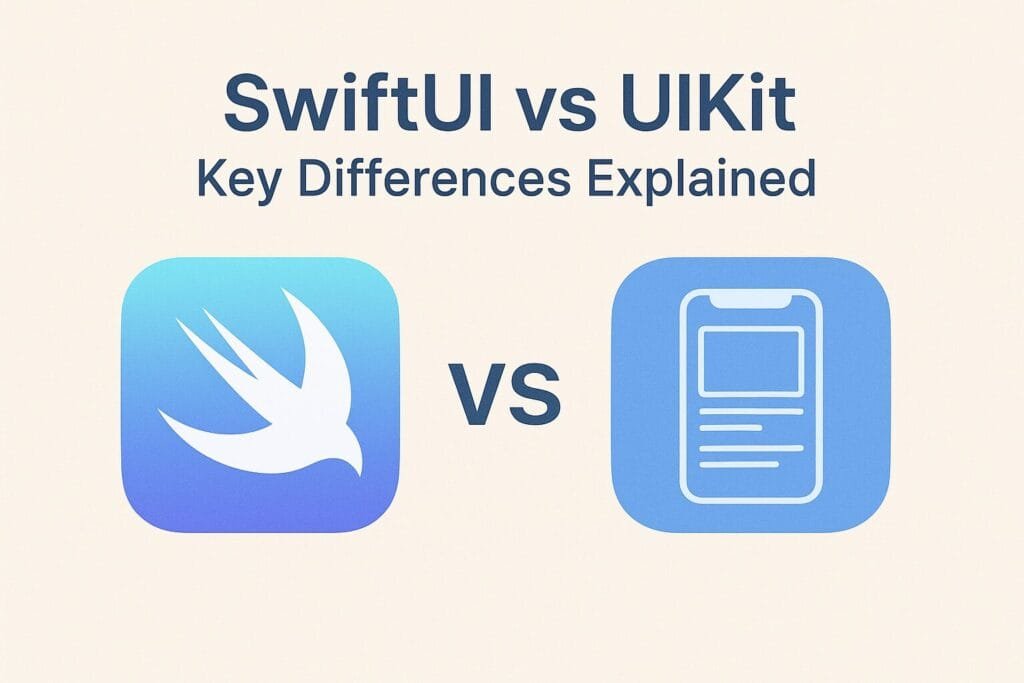When building iOS apps, developers have two main options for constructing user interfaces: SwiftUI and UIKit. Although both are developed by Apple and allow for the creation of beautiful, responsive applications, they are fundamentally different in approach, learning curve, performance, and integration.

1. Declarative vs Imperative
The most striking difference between SwiftUI and UIKit lies in their programming paradigms. SwiftUI is a declarative framework, which means you declare what the UI should look like, and the framework takes care of updating it when data changes. In contrast, UIKit follows an imperative approach, requiring you to manually manage the state and transitions of the UI.
This makes SwiftUI code typically shorter, easier to understand, and more maintainable—especially in dynamic UIs where data frequently changes.
2. Compatibility and Platform Support
SwiftUI is available on iOS 13 and later, and it also supports watchOS, macOS, and tvOS. It enables cross-platform UI development, whereas UIKit is strictly for iOS and tvOS. This cross-platform capability makes SwiftUI a powerful tool for teams building applications across the Apple ecosystem.
However, UIKit still provides broader compatibility with legacy projects and apps that need to support older iOS versions.
3. Learning Curve and Development Speed
For developers new to iOS, SwiftUI offers a more modern and intuitive way to build apps. Features like live previews in Xcode and fewer lines of code speed up development significantly. On the other hand, UIKit comes with a steep learning curve due to its verbose syntax and larger API surface.
That said, UIKit still offers greater control over layout, animation, and interaction, making it the preferred choice for more complex or highly customized apps.
4. Community and Maturity
UIKit has been around since 2008 and has a mature ecosystem with tons of third-party libraries, Stack Overflow answers, and developer support. SwiftUI, introduced in 2019, is still evolving. While it’s improving with each iOS release, it may lack features or documentation, especially for advanced use cases.
For teams working on production-grade applications, UIKit might still be the safer bet, although SwiftUI is quickly catching up.
5. Integration and Interoperability
The good news is that SwiftUI and UIKit can be used together. You can integrate SwiftUI views inside UIKit projects using UIHostingController, or bring UIKit components into SwiftUI with UIViewRepresentable. This makes gradual migration feasible for larger projects.
Comparison Table
| Feature | SwiftUI | UIKit |
|---|---|---|
| Programming Style | Declarative | Imperative |
| Platform Support | Cross-platform (iOS, macOS, etc) | Primarily iOS |
| Learning Curve | Easier | Steep |
| Customization Flexibility | Limited (evolving) | High |
| Interoperability | Yes (via wrappers) | Yes |
| Community Maturity | Newer (since 2019) | Mature (since 2008) |
Which One Should You Use?
Choosing between SwiftUI and UIKit depends on your project requirements, target audience, and developer experience. For newer apps targeting modern iOS versions, SwiftUI can significantly reduce development time. For enterprise apps with advanced UI requirements or older device support, UIKit remains a solid choice.
To dive deeper into SwiftUI’s capabilities, Apple’s official documentation offers comprehensive guidance and examples.

